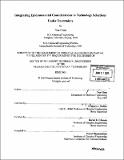Integrating environmental considerations in technology selections under uncertainty
Author(s)
Chen, Yue (Yue Nina)
DownloadFull printable version (10.14Mb)
Other Contributors
Massachusetts Institute of Technology. Dept. of Chemical Engineering.
Advisor
Gregory J. McRae and Karen K. Gleason.
Terms of use
Metadata
Show full item recordAbstract
Competition requires companies to make decisions that satisfy multiple criteria. Considering profitability alone is no longer sufficient. Ignoring environmental considerations will not only expose a company to potential regulatory costs, but also damaged public image, both of which in turn have negative effect on the economic well- being of companies. At the same time, the fast changing business environment requires companies to reach decisions in a speedy fashion. This work describes a decision- making framework that addresses the obstacles in integrating environmental considerations into technology selections with focus on the semiconductor and flat panel industry. It addresses data availability and data quality issues in environmental evaluations through the uncertainty analysis. It tackles the mismatch between the short innovation cycles in the industry and the long environmental analysis time by a combination of the uncertainty analysis, non-linear sensitivity analysis, hierarchical modeling, and the value of information analysis. It bridges the gap between environmental evaluations, economical evaluations, and technical evaluations by a unified modeling platform that links the process model, the cost-of-ownership model, and the environmental valuation model along with the databases and the random number generators for the uncertainty analysis. It is a generic framework and can be applied to various decision scenarios that face uncertainty in their systems. The paper also reviews sensitivity analysis methods and includes a survey on the current status and needs on environmental, safety, and health in the industry. (cont.) A case study on Cu CVD illustrates the methods of the evaluations models. A case study on comparing NF₃ and F₂ as the chamber cleaning gas illustrates the decision-making framework.
Description
Thesis (Ph. D.)--Massachusetts Institute of Technology, Dept. of Chemical Engineering, 2005. Includes bibliographical references (p. 151-157).
Date issued
2005Department
Massachusetts Institute of Technology. Department of Chemical EngineeringPublisher
Massachusetts Institute of Technology
Keywords
Chemical Engineering.